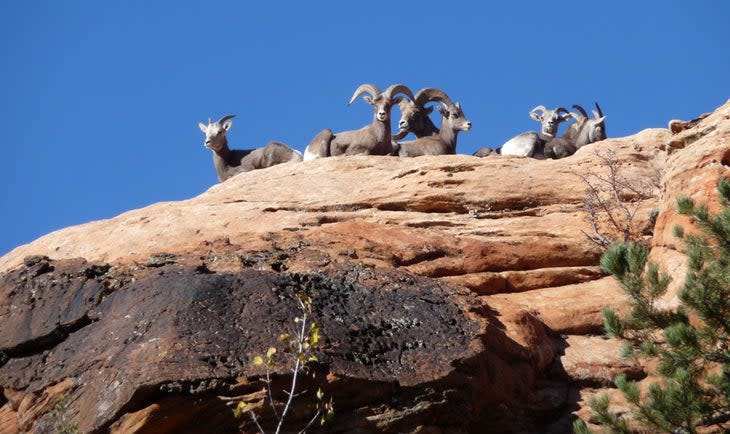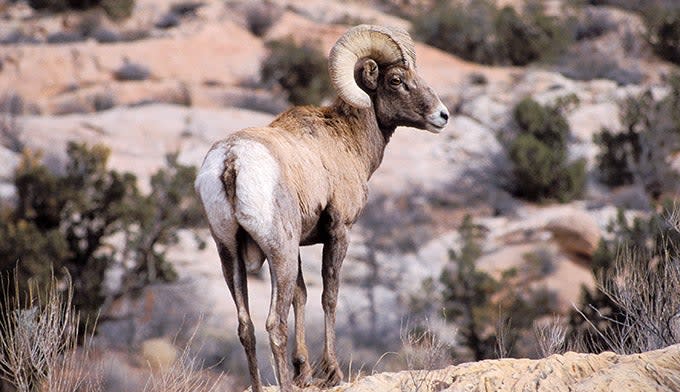See Bighorn Sheep in Southern Utah
This article originally appeared on My Utah Parks
Utah has both bighorn sheep and mountain goats, but only the sheep live in the southern half of the state. Two species of bighorn sheep can be found here, the California Bighorn Sheep and the Desert Bighorn Sheep.
The California bighorn sheep, like its cousin the mountain goat, prefers rocky, mountainous areas where it eats grasses, sagebrush, sedges and forbs. Look for one or two lambs beside their mom in spring when small herds may be seen foraging for spring greens. The California bighorn may have been native to Utah in ancient times, but if so, it wasn’t here by the time Europeans arrived. The Utah Division of Wildlife Resources and the Utah Division of Parks and Recreation on Antelope Island coordinated to establish a breeding herd here.
The desert bighorn sheep (also called “Nelson's bighorn sheep”) is more common. Desert bighorns have adapted to hot, dry climates, unlike their Rocky Mountain cousins, and have longer legs, lighter coats and smaller bodies. Look for movement on the side of dry, rocky cliffs where, once your eye is adjusted, you may see small herds on what looks like impassable terrain. They roam throughout the desert and mountains of southeast Utah and down throughout Nevada into Mexico, particularly in areas that border the Colorado River or its tributaries. Native to Utah, they can go for long periods without drinking water, like a camel.
Too Few Bighorn Sheep, Then Too Many

Once a dwindling population, bighorn sheep have made a comeback. Almost too much though.
In 1975, Utah's population numbered around 1,000 sheep. In 2015, the bighorn population in Utah was estimated at 3,000 animals.
Biologists began relocating bighorns from a native population in the early 1980s, in Canyonlands National Park in order to establish new herds. Since sheep are poor dispersers, this is the only way to return them to their historic ranges. To accomplish this, sheep are captured in nets fired from helicopters, their health and age assessed, and suitable animals are transported by ground to a relocation area.
When bighorn were in decline in and around Zion National Park, Utah Wildlife Management reintroduced them to the region. That didn’t go so well. The sheep dwindled down to previous low numbers. But then, the sheep surprised everyone and made a huge comeback. Bighorn sheep are thriving in such high numbers that officials are studying them to see if action needs to be taken.
Watch the Bighorn Sheep Rut in Early December

Early December is the perfect time to see bighorn sheep.
“Bighorns are in the rut this time of year, so they’re less wary of people,” says Brent Stettler, regional conservation outreach manager for the Utah Division of Wildlife Resources. “Because they’re focused on courtship and breeding, they’ll allow vehicles to get closer to them than they normally would.”
During the rut, Stettler says equally matched rams will occasionally engage in head-butting. “At other times,” he says, “a superior ram will harass or drive off a smaller ram.”
Hot spots for viewing bighorn sheep in their rut include Moab and Green River, Utah. Each of these national park gateway towns have held past annual events for watching with wildlife biologists.
For exclusive access to all of our fitness, gear, adventure, and travel stories, plus discounts on trips, events, and gear, sign up for Outside+ today.

